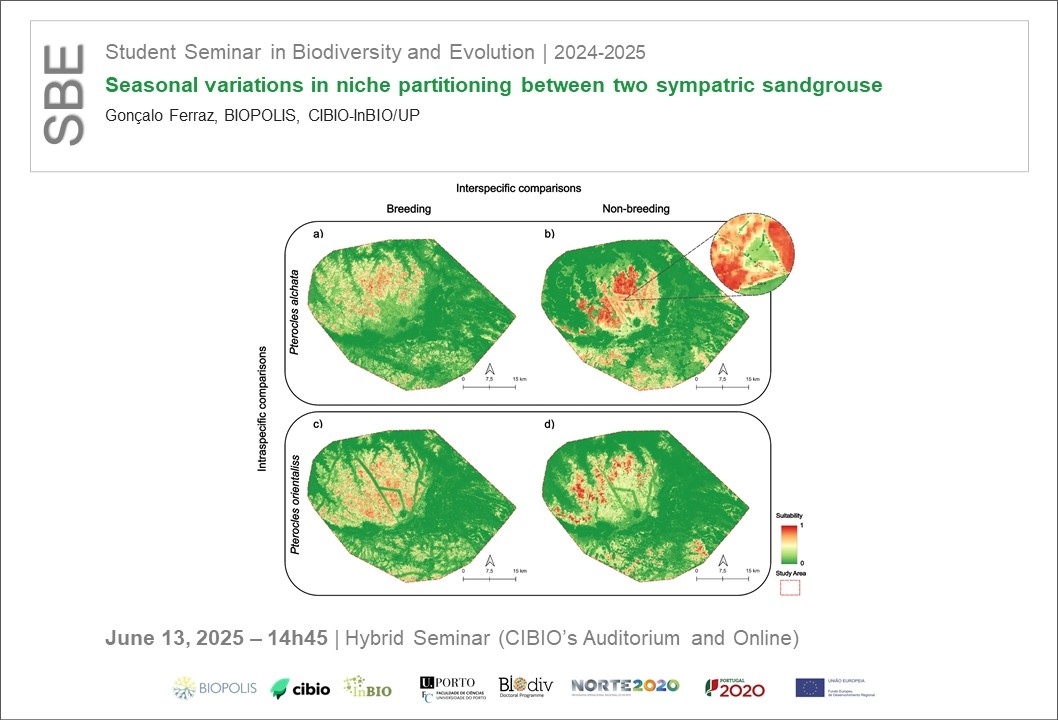Seasonal variations in niche partitioning between two sympatric sandgrouse
13 Jun 2025 - Gonçalo Ferraz, BIOPOLIS, CIBIO-InBIO/UP | 14h45 | Hybrid Seminar

STUDENT SEMINAR IN BIODIVERSITY AND EVOLUTION
[Host: Paulo Célio Alves, Conservation Genetics and Wildlife Management - CONGEN]
Zoom Link: https://videoconf-colibri.zoom.us/j/99764286136
Ecologists have long sought to understand how species with similar ecological niches coexist, especially in sympatric environments. Traditional studies using low-resolution presence and environmental data have provided insights into these processes but often focus on a single season (mainly breeding) and are limited in capturing spatiotemporal environmental variation. Recent developments in satellite data and high-resolution biologging now enable researchers to better understand species coexistence and distribution in dynamic ecosystems. Sandgrouse (Pteroclidae) are ideal for studying niche dynamics and coexistence due to their narrow environmental requirements year-round. Here, we investigated habitat suitability and niche overlap between pin-tailed (Pterocles alchata) and black-bellied sandgrouse (Pterocles orientalis) in a Special Protection Area in southwestern Iberia, where both species occur in sympatry year-round. From 2021 to 2023, we tracked 35 P. alchata and 26 P. orientalis using high-resolution GPS devices, matching locations with 10-metre resolution environmental and anthropogenic variables from Sentinel-1 and -2 satellite imagery collected every six days. We applied random forest models across seasons to identify variables influencing each species' niche and to predict habitat suitability. Ecological niches were compared in environmental and geographic space, alongside patterns of space use, and niche overlap was quantified across species and seasons using Horn's R and Schoener's D indices. Our models predicted habitat suitability at a very high 10-metre resolution. In environmental space, we found moderate to high niche overlap across species and seasons, with habitat-related variables shaping both species’ niches across seasons. Between species, niche overlap was higher during the breeding season, while P. alchata showed greater seasonal niche segregation than P. orientalis. Despite shared ecological requirements, analyses in geographic space showed distinct patterns between suitability projections and actual space use, indicating that spatial segregation is likely promoted not only by seasonal variations in suitability but also by other ecological processes, facilitating sandgrouse coexistence.
Gonçalo Ferraz is a biologist and BIODIV PhD student in the TRACE research group at BIOPOLIS/CIBIO-InBIO. His primary research interests centre on the processes that shape species ecology, evolution, and population dynamics. During his PhD, Gonçalo has focused to the ecology and population dynamics of two steppe bird species that have undergone significant population declines in recent decades: the black-bellied sandgrouse (Pterocles orientalis) and the pin-tailed sandgrouse (Pterocles alchata). By examining different but complementary aspects of both species’ biology in the Iberian Peninsula (such as movement and niche ecology or reproductive success), Gonçalo aims to understand how these species adapt to a changing environment, increasingly impacted by climate change, agricultural intensification, and, more recently, land use changes to accommodate renewable energy infrastructures. Ultimately, Gonçalo's research integrates the TRACE research group's efforts to better understand the ecology of Iberian steppe species and outline effective conservation measures to halt their decline.
[Host: Paulo Célio Alves, Conservation Genetics and Wildlife Management - CONGEN]
Zoom Link: https://videoconf-colibri.zoom.us/j/99764286136